Introduction
Vietnam is globally recognized for its terraced rice fields, especially those in the North, which captivate photographers with their striking beauty. These landscapes are not mere backdrops; they are the result of the arduous labor of various ethnic communities whose soul and culture are intrinsically linked to these crops. Beyond their visual appeal, they represent a living heritage, shaped by generations.
Here is an overview of the most beautiful terraced rice fields in Northern Vietnam, with indications of the best times to visit and how to get there.
Mu Cang Chai (Lào Cai Province)
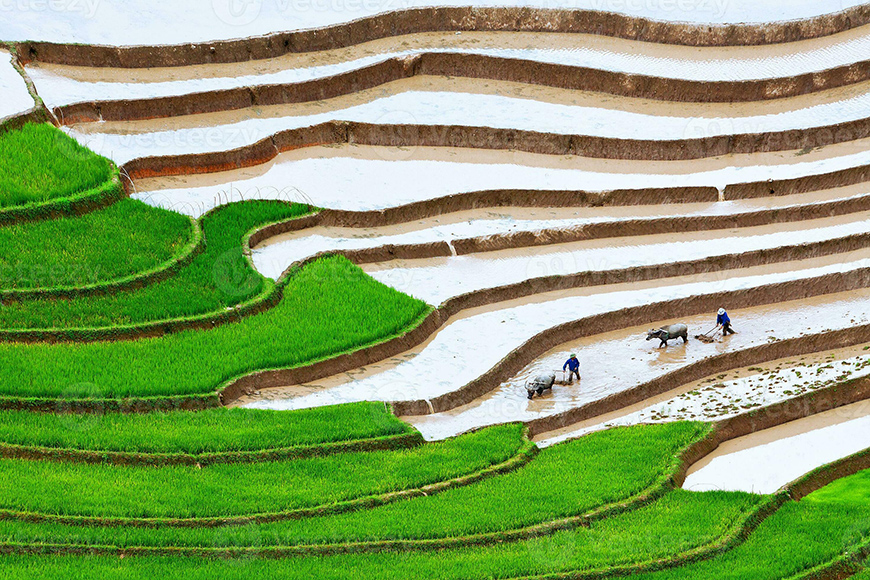 Mù Cang Chải is known for it's terraced rice field views with endless photo opportunities
Mù Cang Chải is known for it's terraced rice field views with endless photo opportunities
Among the must-see sites, Mu Cang Chai, in the former Yên Bái province, is a true paradise for photographers.
Here, the terraced rice fields harmonize with the canyons, creating postcard-worthy landscapes, particularly around the villages of La Pan Tan, Che Cu Nha, and De Xu Phinh. The Khau Pha Pass also offers exceptional panoramic views. These living works of art are primarily the result of the incessant labor of the Hmong people, who constitute about 90% of the district's population. Their way of life, traditions, and very soul are deeply rooted in these hand-sculpted landscapes, testaments to a remarkable adaptation to a demanding environment.
Rice field calendar
- ♦ Mirror season (watering and transplanting): May to June.
- ♦ Jade season (growing, vibrant green): June to August.
- ♦ Golden season (harvest): Late September to early October.
Access from Hanoi
Mu Cang Chai is accessible by bus or car from Hanoi, with the journey taking about 6 to 7 hours.
Sapa (Lào Cai Province)
 Sapa's rice fields iare ranked among the top 7 most beautiful rice fields in the world. - Mr Linh's Adventures
Sapa's rice fields iare ranked among the top 7 most beautiful rice fields in the world. - Mr Linh's Adventures
A former French colonial retreat, Sapa, located in Lào Cai province, is now famous for its terraced rice fields, considered by some media as among the most beautiful in the world.
The region attracts millions of tourists each year, who can enjoy magnificent guided hikes by the Hmong and Dao populations through the Muong Hoa valley and the villages of Ta Phin and Lao Chai. Sapa's dizzying rice fields are surrounded by high peaks and ethnic villages like Lao Chai, Ta Van, or Ban Ho, making it an ideal place for hiking and discovering the Hmong, Dao, and Giay communities. The Hmong ethnic group is the largest in Sapa, making up 52% of the population, followed by the Red Dao (25%).
Rice field calendar
- ♦ Mirror season: May to June.
- ♦ Jade season: June to August.
- ♦ Golden season: Late September to early October.
Access from Hanoi
Sapa is easily accessible from Hanoi by overnight train or bus. The train journey takes about 8 to 9 hours to Lao Cai, then a short bus ride to Sapa. Direct buses are also an option, taking about 5 to 6 hours.
Bac Ha (Lào Cai Province)
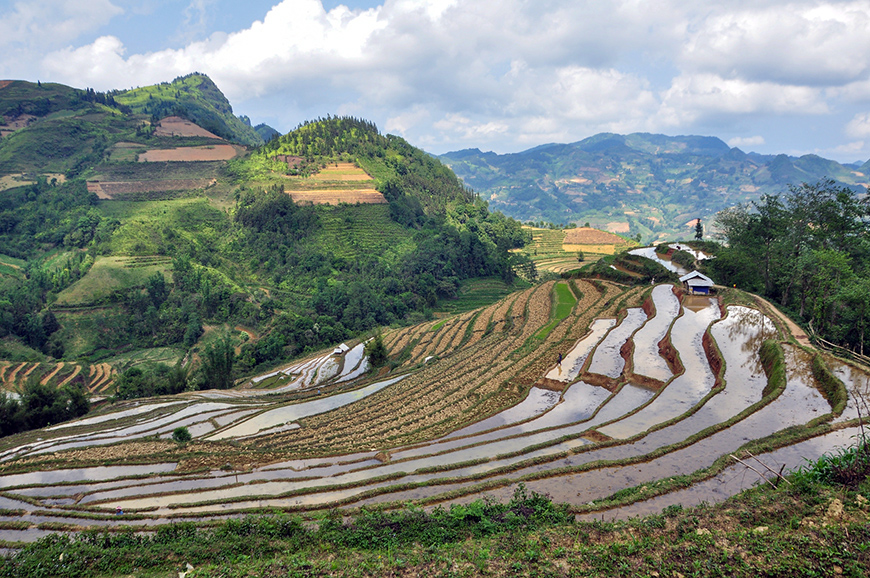 The Bac Ha area offers a splendid view of the rice fields in the middle of the mountains - Mr Linh's Adventures
The Bac Ha area offers a splendid view of the rice fields in the middle of the mountains - Mr Linh's Adventures
East of Sapa, in Lào Cai province, lies
Bac Ha. Its rice fields are less spectacular than Sapa's, but more intimate and authentic, away from tourist crowds.
The Bac Ha district, especially
Ta Cu Ty, offers magnificent mountainous and rice-growing panoramas, with
discreet trails and more
authentic encounters. Bac Ha is home to over
18 ethnic groups, including the Hmong (Hmong Hoa or Flower Hmong), who represent about half of the district's population, as well as the Dao, Tay, and Nung.
Rice field calendar:
- ♦ Mirror season: May to June.
- ♦ Jade season: June to August.
- ♦ Golden season: Late September to early October.
Access from Hanoi
Bac Ha is accessible by bus from Hanoi (about 6-7 hours) or by train to Lao Cai, then by local bus (about 2 hours).
Hoang Su Phi (Ha Giang Province)
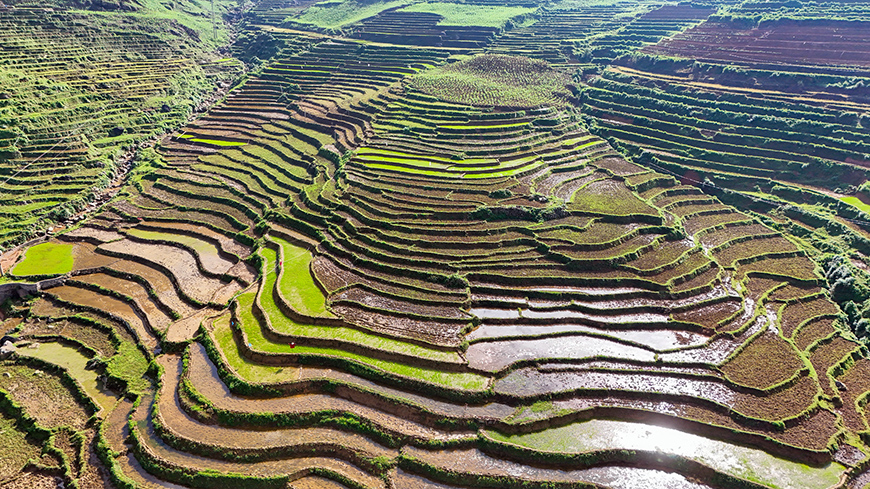 Hoang Su Phi is renowned for its breathtaking terraced rice fields - Mr Linh's Adventures
Hoang Su Phi is renowned for its breathtaking terraced rice fields - Mr Linh's Adventures
At the borders of Vietnam, near the Chinese border, Hoang Su Phi, in Ha Giang province, is a preserved and wild region, ideal for hiking at the foot of Tay Con Linh mountain.
Classified as a national heritage site, Hoang Su Phi is famous for its incredible ethnic diversity and spectacular "waves" of terraced rice fields in the villages of Ban Luoc, Thong Nguyen, and Nam Ty. Exploring this region is ideally done via its many dirt roads, sometimes unpaved, through large bamboo forests, with the help of local Dao, Nung, or Chi guides. The rice fields are the result of the work of the Dao and Nung communities (in Ban Luoc and San Sa Ho), the La Chi (in Ban Phung), and the Red Dao (in Ho Thau, Nam Ty, and Thong Nguyen).
Rice field calendar
- ♦ Mirror season: May to June.
- ♦ Jade season: June to August.
- ♦ Golden season (harvest): September to October, offering breathtaking golden landscapes.
Access from Hanoi
Hoang Su Phi is more difficult to access. One must take an overnight bus to Ha Giang (about 6-7 hours), then another bus or rent a motorbike to Hoang Su Phi (about 3-4 additional hours).
Ban Gioc Waterfalls and Trung Khanh (Cao Bang Province)
 Ban Gioc waterfall, the hidden corner of beautiful rice fields in Cao Bang - Mr Linh's Adventures Team
Ban Gioc waterfall, the hidden corner of beautiful rice fields in Cao Bang - Mr Linh's Adventures Team
Between land and water, on the borders of Vietnam and China,
Cao Bang province presents a striking landscape of undulating rice fields and the Ban Gioc Waterfalls, Vietnam's most impressive cascade.
Autumn is particularly beautiful when the rice fields bordering the waterfall turn brilliant yellow, blending with the Quay Son river and the mountains. The main ethnic groups in Cao Bang, involved in agriculture and rice field maintenance, are the Tay (the largest ethnic minority in the province),
the Nung, the Red Dao, and the Hmong.
Rice field calendar
- ♦ Mirror season: May to June.
- ♦ Jade season: June to August.
- ♦ Golden season (harvest): Autumn, when the rice fields turn brilliant yellow.
Access from Hanoi
To reach Cao Bang, one must take an overnight bus from Hanoi (about 7-8 hours). From Cao Bang, it is possible to rent a motorbike or a taxi to get to Ban Gioc Waterfalls and Trung Khanh.
Pu Luong Nature Reserve (Thanh Hoa Province)
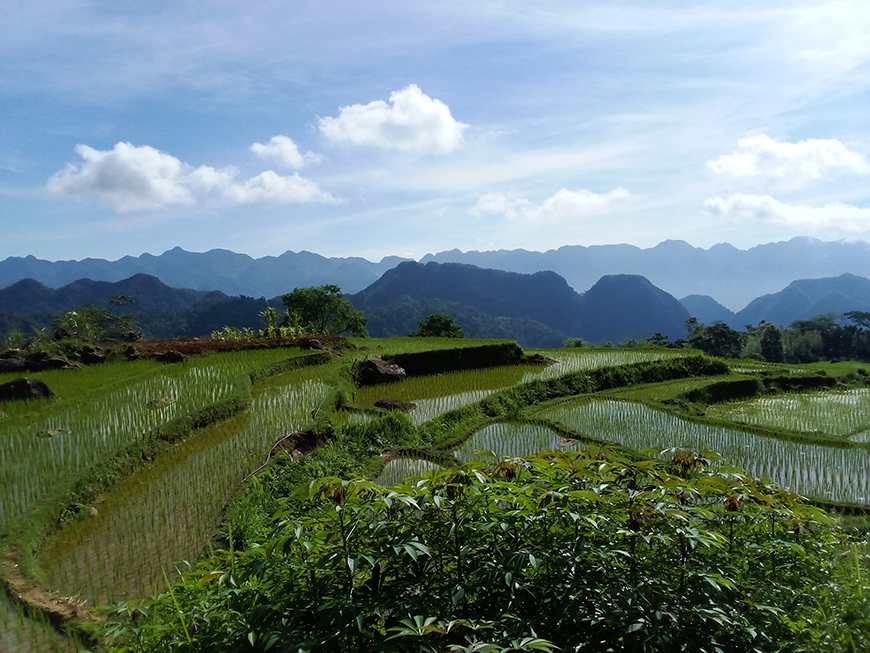 Pu Luong's terraced rice fields offer a serene alternative to Sapa in Northern Vietnam - Mr Linh's Adventures Team
Pu Luong's terraced rice fields offer a serene alternative to Sapa in Northern Vietnam - Mr Linh's Adventures Team
The Pu Luong Nature Reserve, in Thanh Hoa province, is located next to the Mai Chau valley.
Its typical landscape is composed of tropical forests on high limestone mountains and peaceful rural villages inhabited by ethnic minorities who have created terraced crops by drawing water from streams. Many water wheels are present for agriculture. The majority of communities in the reserve are Thai populations, with two local branches: the White Thai and the Black Thai. They are very skilled in wet rice cultivation.
Rice field calendar
The two annual harvests dictate the landscape from March to October.
- ♦ Mirror season: March-April and July-August.
- ♦ Jade season: April-July and August-October.
- ♦ Golden season: Generally late May-early June and September-October.
Access from Hanoi
Pu Luong is accessible by bus or car from Hanoi (about 4-5 hours).
Tam Coc and the inland bay of Ninh Binh
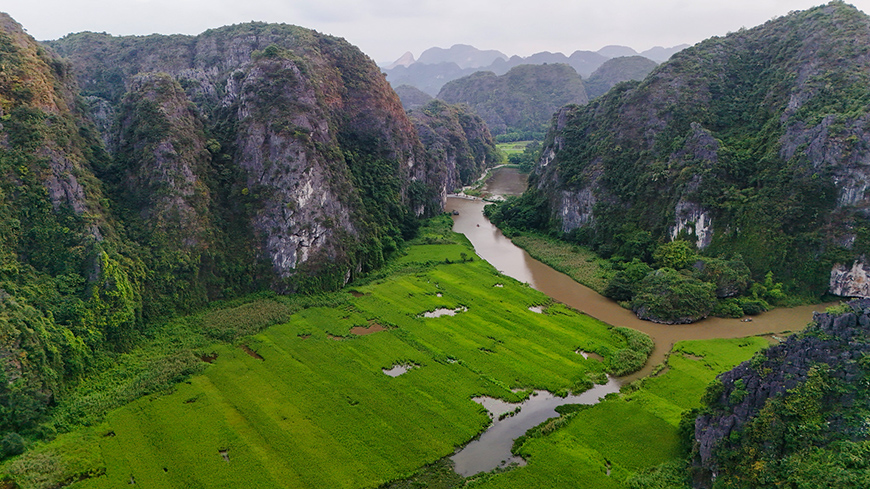 Ninh Binh rice fields offer some of Vietnam's most stunning vistas - Mr Linh's Adventures
Ninh Binh rice fields offer some of Vietnam's most stunning vistas - Mr Linh's Adventures
Further south, Tam Coc, in the inland bay of
Ninh Binh, is an emblematic destination.
Its rice fields are located between the
Ngo Dong River and limestone cliffs, and can be admired by boat or from the top of Ngoa Long mountain. Due to limited water supply, Tam Coc produces only one rice crop, sown in January and harvested in May. The golden rice fields of Tam Coc are particularly anticipated each year in late May, and a festival is organized to celebrate their beauty. The Ninh Binh region is mainly inhabited by the Kinh ethnic group (the majority in Vietnam), but also by Tay, Dao, Nung, and Hmong who contribute to agricultural diversity.
Rice field calendar
- ♦ Mirror season (sowing): January.
- ♦ Jade season: February to April.
- ♦ Golden season (harvest): May.
Access from Hanoi
Tam Coc (Ninh Binh) is very easily accessible from Hanoi by train (about 2 hours 30 minutes) or by bus (about 2 hours).
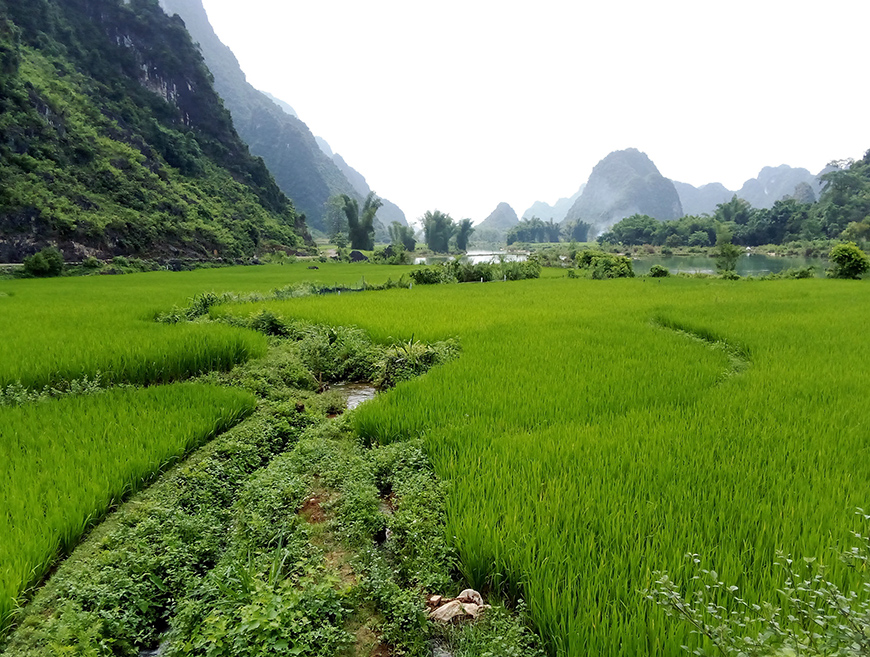 Cao Bang's rice fields in Truong Khanh and Quang Uen captivate visitors - Mr Linh's Adventures Team
Cao Bang's rice fields in Truong Khanh and Quang Uen captivate visitors - Mr Linh's Adventures TeamRice fields in practice
To
explore Northern Vietnam, a combination of walking, car, and motorbike can be an excellent option.
It is essential to choose sites that best match your expectations, as the experience can vary, ranging from comfortable hotels in Sapa to more rustic accommodations in Hoang Su Phi. Beyond these sites, other exceptional places like Meo Vac and
Ba Be are also worth discovering.
Feel free to contact us to discuss further!